modeltest1
- 格式:doc
- 大小:42.00 KB
- 文档页数:11
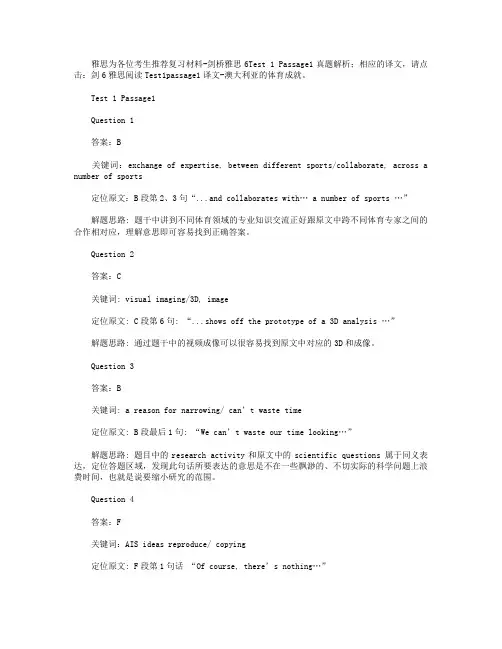
雅思为各位考生推荐复习材料-剑桥雅思6Test 1 Passage1真题解析;相应的译文,请点击:剑6雅思阅读Test1passage1译文-澳大利亚的体育成就。
Test 1 Passage1Question 1答案:B关键词:exchange of expertise, between different sports/collaborate, across a number of sports定位原文:B段第2、3句“...and collaborates with… a number of sports …”解题思路: 题干中讲到不同体育领域的专业知识交流正好跟原文中跨不同体育专家之间的合作相对应,理解意思即可容易找到正确答案。
Question 2答案:C关键词: visual imaging/3D, image定位原文: C段第6句: “...shows off the prototype of a 3D analysis …”解题思路: 通过题干中的视频成像可以很容易找到原文中对应的3D和成像。
Question 3答案:B关键词: a reason for narrowing/ can’t waste time定位原文: B段最后1句: “We can’t waste our time looking…”解题思路: 题目中的research activity和原文中的scientific questions 属于同义表达,定位答题区域,发现此句话所要表达的意思是不在一些飘渺的、不切实际的科学问题上浪费时间,也就是说要缩小研究的范围。
Question 4答案:F关键词:AIS ideas reproduce/ copying定位原文: F段第1句话“Of course, there’s nothing…”解题思路: 题干中的reproduce是复制的意思,之后从文章中发现句子有复制copying,即可以直接定位。
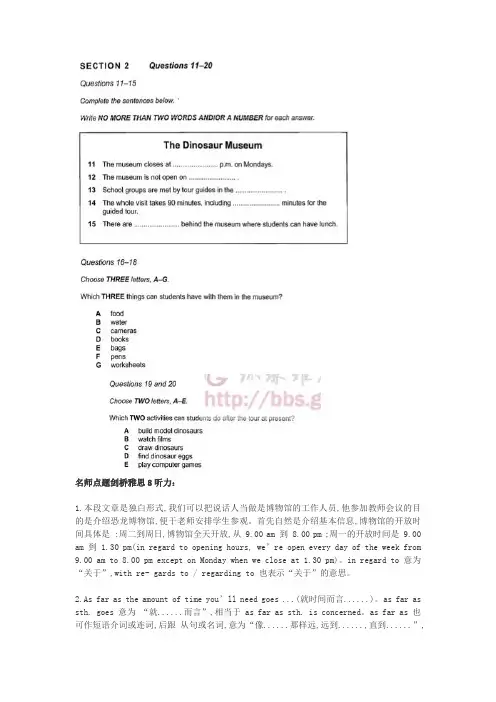
名师点题剑桥雅思8听力:1.本段文章是独白形式,我们可以把说话人当做是博物馆的工作人员,他参加教师会议的目的是介绍恐龙博物馆,便于老师安排学生参观。
首先自然是介绍基本信息,博物馆的开放时间具体是 :周二到周日,博物馆全天开放,从 9.00 am 到 8.00 pm ;周一的开放时间是 9.00 am 到1.30 pm(in regard to opening hours, we’re open every day of the week from 9.00 am to 8.00 pm except on Monday when we close at 1.30 pm)。
in regard to 意为“关于”,with re- gards to / regarding to 也表示“关于”的意思。
2.As far as the amount of time you’ll need goes ...(就时间而言......)。
as far as sth. goes 意为“就......而言”,相当于 as far as sth. is concerned。
as far as 也可作短语介词或连词,后跟从句或名词,意为“像......那样远,远到......,直到......”,如 :You can see as far as the coast.(极目远眺,你可以看到海岸)。
3.工作人员介绍说“博物馆里面有两个咖啡馆,可以容纳 80 人。
如果想在那里吃饭,需要预定座位,因为午餐时间那里很拥挤”(There are two cafes in the museum, with seating for 80 people. If you want to eat there you’ll need to reserve some seating, as they can get quite crowded at lunch time)。

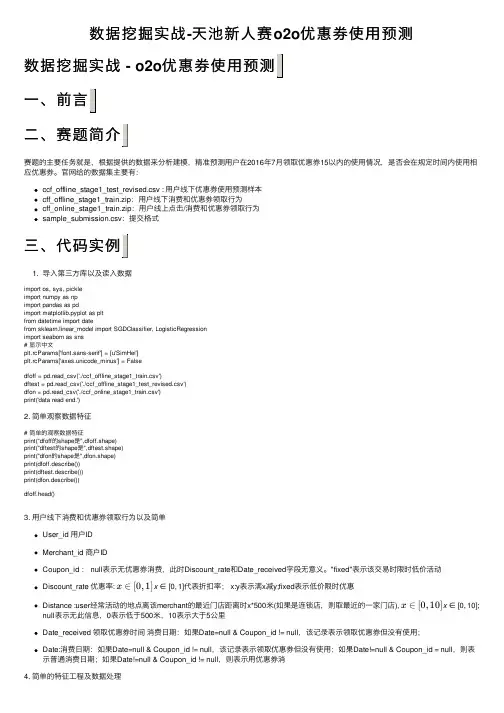
数据挖掘实战-天池新⼈赛o2o 优惠券使⽤预测数据挖掘实战 - o2o优惠券使⽤预测⼀、前⾔⼆、赛题简介赛题的主要任务就是,根据提供的数据来分析建模,精准预测⽤户在2016年7⽉领取优惠券15以内的使⽤情况,是否会在规定时间内使⽤相应优惠券。
官⽹给的数据集主要有:ccf_offline_stage1_test_revised.csv : ⽤户线下优惠券使⽤预测样本cff_offline_stage1_train.zip :⽤户线下消费和优惠券领取⾏为cff_online_stage1_train.zip :⽤户线上点击/消费和优惠券领取⾏为sample_submission.csv :提交格式三、代码实例1. 导⼊第三⽅库以及读⼊数据import os, sys, pickleimport numpy as npimport pandas as pdimport matplotlib.pyplot as pltfrom datetime import datefrom sklearn.linear_model import SGDClassifier, LogisticRegressionimport seaborn as sns# 显⽰中⽂plt.rcParams['font.sans-serif'] = [u'SimHei']plt.rcParams['axes.unicode_minus'] = Falsedfoff = pd.read_csv('./ccf_offline_stage1_train.csv')dftest = pd.read_csv('./ccf_offline_stage1_test_revised.csv')dfon = pd.read_csv('./ccf_online_stage1_train.csv')print('data read end.')2. 简单观察数据特征# 简单的观察数据特征print("dfoff 的shape 是",dfoff.shape)print("dftest 的shape 是",dftest.shape)print("dfon 的shape 是",dfon.shape)print(dfoff.describe())print(dftest.describe())print(dfon.describe())dfoff.head()3. ⽤户线下消费和优惠券领取⾏为以及简单User_id ⽤户IDMerchant_id 商户IDCoupon_id : null 表⽰⽆优惠券消费,此时Discount_rate 和Date_received 字段⽆意义。
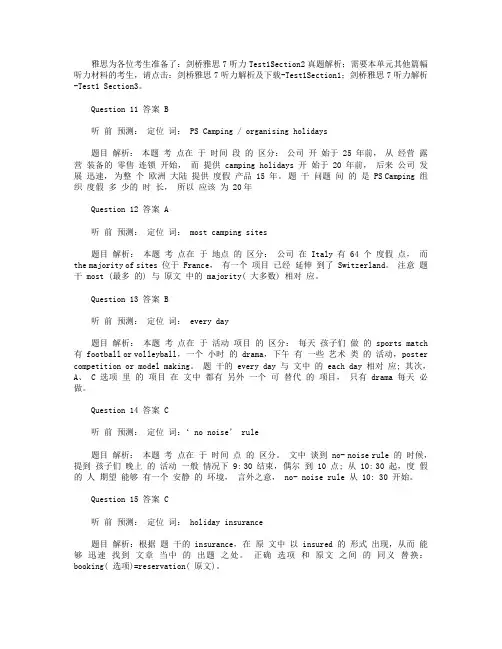
雅思为各位考生准备了:剑桥雅思7听力Test1Section2真题解析;需要本单元其他篇幅听力材料的考生,请点击:剑桥雅思7听力解析及下载-Test1Section1;剑桥雅思7听力解析-Test1 Section3。
Question 11 答案 B听前预测:定位词: PS Camping / organising holidays题目解析:本题考点在于时间段的区分:公司开始于 25 年前,从经营露营装备的零售连锁开始,而提供 camping holidays 开始于 20 年前,后来公司发展迅速,为整个欧洲大陆提供度假产品 15 年。
题干问题问的是 PS Camping 组织度假多少的时长,所以应该为 20年Question 12 答案 A听前预测:定位词: most camping sites题目解析:本题考点在于地点的区分:公司在 Italy 有 64 个度假点,而the majority of sites 位于 France,有一个项目已经延伸到了 Switzerland。
注意题干 most (最多的) 与原文中的 majority( 大多数) 相对应。
Question 13 答案 B听前预测:定位词: every day题目解析:本题考点在于活动项目的区分:每天孩子们做的 sports match 有 football or volleyball,一个小时的 drama,下午有一些艺术类的活动, poster competition or model making。
题干的 every day 与文中的 each day 相对应; 其次,A、 C 选项里的项目在文中都有另外一个可替代的项目,只有 drama 每天必做。
Question 14 答案 C听前预测:定位词:‘ no noise’ rule题目解析:本题考点在于时间点的区分。
文中谈到 no- noise rule 的时候,提到孩子们晚上的活动一般情况下 9: 30 结束,偶尔到 10 点; 从 10: 30 起,度假的人期望能够有一个安静的环境,言外之意, no- noise rule 从 10: 30 开始。
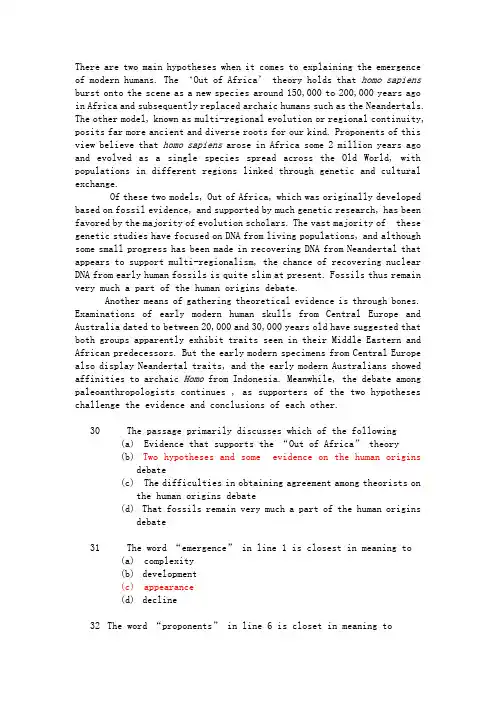
There are two main hypotheses when it comes to explaining the emergence of modern humans. The ‘Out of Africa’ theory holds that homo sapiens burst onto the scene as a new species around 150,000 to 200,000 years ago in Africa and subsequently replaced archaic humans such as the Neandertals. The other model, known as multi-regional evolution or regional continuity, posits far more ancient and diverse roots for our kind. Proponents of this view believe that homo sapiens arose in Africa some 2 million years ago and evolved as a single species spread across the Old World, with populations in different regions linked through genetic and cultural exchange.Of these two models, Out of Africa, which was originally developed based on fossil evidence, and supported by much genetic research, has been favored by the majority of evolution scholars. The vast majority of these genetic studies have focused on DNA from living populations, and although some small progress has been made in recovering DNA from Neandertal that appears to support multi-regionalism, the chance of recovering nuclear DNA from early human fossils is quite slim at present. Fossils thus remain very much a part of the human origins debate.Another means of gathering theoretical evidence is through bones. Examinations of early modern human skulls from Central Europe and Australia dated to between 20,000 and 30,000 years old have suggested that both groups apparently exhibit traits seen in their Middle Eastern and African predecessors. But the early modern specimens from Central Europe also display Neandertal traits, and the early modern Australians showed affinities to archaic Homo from Indonesia. Meanwhile, the debate among paleoanthropologists continues , as supporters of the two hypotheses challenge the evidence and conclusions of each other.30The passage primarily discusses which of the following(a)Evidence that supports the “Out of Africa” theory(b)Two hypotheses and some evidence on the human originsdebate(c)The difficulties in obtaining agreement among theorists onthe human origins debate(d)That fossils remain very much a part of the human originsdebate31The word “emergence” in line 1 is closest in meaning to(a)complexity(b)development(c)appearance(d)decline32The word “proponents” in line 6 is closet in meaning to(a)experts(b)advocates(c)inspectors(d)historians33All of the following are true except(a)three methods of gathering evidence are mentioned in thepassage(b)the multi-regional model goes back further in history.(c)the Out of Africa model has had more support from scholars(d)DNA studies offer one of the best ways in future to provideclear evidence.34The word “slim” in line 14 is closest in meaning to(a)small(b)narrow(c)thin(d)difficult35Which of the following is not true(a)the vast majority of genetic studies have focused on livingpopulations(b)early modern human skulls all support the same conclusions(c)both hypotheses focus on Africa as a location for the newspecies.(d)early modern Australian skulls have similarities to thosefrom Indonesia.36In line 18, the word “their ” refe rs to which of the following(a)Middle Easterners and Africans(b)skulls(c)central Europeans and Australians(d)traits37Which of the following is NOT true about the two hypotheses(a)Both hypotheses regard Neandertals to be the predecessorsof modern humans(b)Genetic studies have supported both hypotheses(c)Both hypotheses cite Africa as an originating location.(d)One hypothesis dates the emergence of homo sapiens muchearlier than the other.38It can be inferred from the passage that(a)there is likely to be an end to the debate in the near future(b)the debate will interest historians to take part in(c)the debate is likely to be less important in future(d)there is little likelihood that the debate will die down39According to the passage, the multi-regional evolution model posits far more diverse roots for our kind because(a)Evidence from examinations of early modern human skulls hascome from a number of different parts of the world.(b)DNA from Neandertal appears to support multi-regionalism(c)Populations in different regions were linked throughgenetic and cultural exchange(d)This has been supported by fossil evidenceSome people say that the study of liberal arts is a useless luxury we can not afford in hard times. Students, they argue, who do not develop salable skills will find it difficult to land a job upon graduation. But there is a problem in speaking of "salable skills". What skills are salable? Right now, skills for making automobiles are not highly salable, but they have been for decades and might be again. Skills are another example of varying salability, as the job market fluctuates. What's more, if one wants to build a curriculum exclusively on what is salable, one will have to make the courses very short and change them very often, in order to keep up with the rapid changes in the job market. But will not the effort be in vain? In very few things can we be sure of future salability, and in a society where people are free to study what they want, and work where they want, and invest as they want, there is no way to keep supply and demand in labor in perfect accord.A school that devotes itself totally to salable skills, especially in a time of high unemployment, sending young men and women into the world armed with only a narrow range of skills, is also sending lambs into the lion's den. If those people gain nothing more from their studies than supposedly salable skills, and can't make the sale because of changes in the job market, they have been cheated. But if those skills were more than salable, if study gave them a better understanding of the world around them and greater adaptability in a changing world, they have not been cheated. They will find some kind of job soon enough. Flexibility, and ability to change and learn new things, is a valuable skill. People who have learned how to learn can learn outside of school. That is where most of us have learned to do what we do, not in school. Learning to learn is one of the highest liberal skills.52. From the passage, we can learn that the author is in favor of .A) teaching practical skills that can be sold in the current job marketB) a flexible curriculum that changes with the timesC) a liberal educationD) keeping a balance between the supply and demand in the labor market53. The word "fluctuate"(Line 5,Para.1) most probably means .A) remain steadyB) change in an irregular wayC) follow a set patternD) become worse and worse54. According to the author, who of the following is more likely to get a job in times of high unemployment?A) A person with the ability to learn by himself.B) A construction worker.C) A car repairman.D) A person with quite a few salable skills.55. According to the author, in developing a curriculum school should .A) predict the salability of skills in the future job marketB) take the current job market into considerationC) consider what skills are salableD) focus on the ability to adapt to changes56. We can learn from the passage that .A) liberal arts education is being challenged nowB) schools that teach practical skills fare better during hard timesC) extracurricular activities are more important than classroom learningD) many students feel cheated by the educational system。
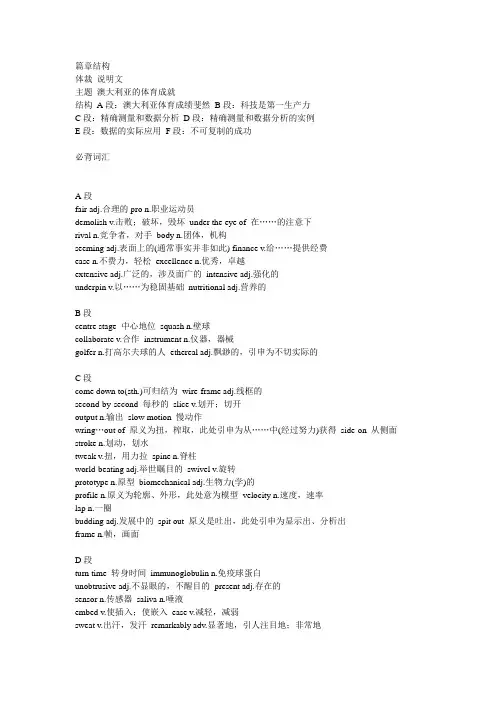
篇章结构体裁说明文主题澳大利亚的体育成就结构A段:澳大利亚体育成绩斐然B段:科技是第一生产力C段:精确测量和数据分析D段:精确测量和数据分析的实例E段:数据的实际应用F段:不可复制的成功必背词汇A段fair adj.合理的pro n.职业运动员demolish v.击败;破坏,毁坏under the eye of 在……的注意下rival n.竞争者,对手body n.团体,机构seeming adj.表面上的(通常事实并非如此) finance v.给……提供经费ease n.不费力,轻松excellence n.优秀,卓越extensive adj.广泛的,涉及面广的intensive adj.强化的underpin v.以……为稳固基础nutritional adj.营养的B段centre stage 中心地位squash n.壁球collaborate v.合作instrument n.仪器,器械golfer n.打高尔夫球的人ethereal adj.飘渺的,引申为不切实际的C段come down to(sth.)可归结为wire-frame adj.线框的second-by-second 每秒的slice v.划开;切开output n.输出slow motion 慢动作wring…out of 原义为扭,榨取,此处引申为从……中(经过努力)获得side-on 从侧面stroke n.划动,划水tweak v.扭,用力拉spine n.脊柱world-beating adj.举世瞩目的swivel v.旋转prototype n.原型biomechanical adj.生物力(学)的profile n.原义为轮廓、外形,此处意为模型velocity n.速度,速率lap n.一圈budding adj.发展中的spit out 原义是吐出,此处引申为显示出、分析出frame n.帧,画面D段turn time 转身时间immunoglobulin n.免疫球蛋白unobtrusive adj.不显眼的,不醒目的present adj.存在的sensor n.传感器saliva n.唾液embed v.使插入;使嵌入ease v.减轻,减弱sweat v.出汗,发汗remarkably adv.显著地,引人注目地;非常地experimentation n.实验,试验immune-system 免疫系统的E段complex adj.复杂的transform v.转换,转变,改变championship n.冠军赛arguably adv.可论证地(可辩论地),有理由说地gear v.调整,(使)适合segment n.部分F段unveil v.展示(新产品);揭开altitude tent 高原帐篷coolant-lined 流线型散热replicate v.复制endurance n.耐力;忍耐力encompass v.包含或包括某事物slice v.减少,降低难句解析1. A lot of their work comes down to measurement—everything from the exact angle of a swimmer's dive to the second-by-second power output of a cyclist.参考译文:许多工作都涉及具体测量,测量内容包括从游泳运动员潜水的精确角度到自行车运动员每秒功率输出的所有数据。
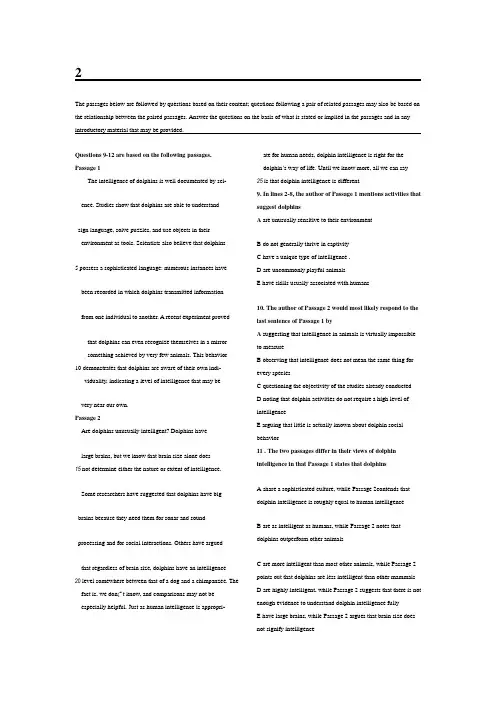
2The passages below are followed by questions based on their content; questions following a pair of related passages may also be based on the relationship between the paired passages. Answer the questions on the basis of what is stated or implied in the passages and in any introductory material that may be provided.Questions 9-12 are based on the following passages. Passage 1The intelligence of dolphins is well documented by sci-ence. Studies show that dolphins are able to understandsign language, solve puzzles, and use objects in their environment as tools. Scientists also believe that dolphins5 possess a sophisticated language: numerous instances havebeen recorded in which dolphins transmitted informationfrom one individual to another. A recent experiment provedthat dolphins can even recognize themselves in a mirrorsomething achieved by very few animals. This behavior10 demonstrates that dolphins are aware of their own indi-viduality, indicating a level of intelligence that may bevery near our own.Passage 2Are dolphins unusually intelligent? Dolphins havelarge brains, but we know that brain size alone does15 not determine either the nature or extent of intelligence.Some researchers have suggested that dolphins have bigbrains because they need them for sonar and soundprocessing and for social interactions. Others have arguedthat regardless of brain size, dolphins have an intelligence20 level somewhere between that of a dog and a chimpanzee. The fact is, we don¡¯t know, and comparisons may not be especially helpful. Just as human intelligence is appropri-ate for human needs, dolphin intelligence is right for the dolphin’s way of life. Until we know more, all we can say25 is that dolphin intelligence is different.9. In lines 2-8, the author of Passage 1 mentions activities that suggest dolphinsA are unusually sensitive to their environmentB do not generally thrive in captivityC have a unique type of intelligence .D are uncommonly playful animalsE have skills usually associated with humans10.The author of Passage 2 would most likely respond to the last sentence of Passage 1 byA suggesting that intelligence in animals is virtually impossible to measureB observing that intelligence does not mean the same thing for every speciesC questioning the objectivity of the studies already conductedD noting that dolphin activities do not require a high level of intelligenceE arguing that little is actually known about dolphin social behavior11 . The two passages differ in their views of dolphin intelligence in that Passage 1 states that dolphinsA share a sophisticated culture, while Passage 2contends that dolphin intelligence is roughly equal to human intelligenceB are as intelligent as humans, while Passage 2 notes that dolphins outperform other animalsC are more intelligent than most other animals, while Passage 2 points out that dolphins are less intelligent than other mammalsD are highly intelligent, while Passage 2 suggests that there is not enough evidence to understand dolphin intelligence fullyE have large brains, while Passage 2 argues that brain size does not signify intelligence12.Which generalization about dolphins is supported by both passages?A They display self-awareness.B They are more emotional than other animals.C They learn at a rapid rate.D They have a certain degree of intelligence.E They have shown the ability to use tools.Questions 13-24 are based on the following passage.The following passage appeared in an essay written in 1987 in which the author, who is of Native American descent, examines the representation of Native Americans during the course of United States history.In many respects living Native Americans remain as mysterious, exotic, and unfathomable to their contempo-raries at the end of the twentieth century as they were to the Pilgrim settlers over three hundred fifty years ago. Native5 rights, motives, customs, languages, and aspirations are misunderstood by Euro-Americans out of a culpable igno-rance that is both self-serving and self-righteous. Part ofthe problem may well stem from the long.b standing ten-dency of European or Euro-American thinkers to regard10 Native Americans as fundamentally and profoundlydifferent, motivated more often by mysticism than byambition, charged more by unfathomable visions thanby intelligence or introspection.This idea is certainly not new. Rousseau’s* “noble15 savages” wandered, pure of heart, through a pristine world. Since native people were simply assumed to be incompre-hensible, they were seldom comprehended. Their societies were simply beheld, often through cloudy glasses, andrarely probed by the tools of logic and deductive analysis 20 automatically reserved for cultures prejudged to be“civilized .”And on those occasions when Europeansdid attempt to formulate an encompassing theory, it was not, ordinarily, on a human-being-to-human-being basis,but rather through an ancestor-descendant model. Native 25 Americans, though obviously contemporary with theirobservers, were somehow regarded as ancient, examplesof what Stone Age Europeans must have been like.It’ s a great story, an international crowd pleaser, butthere is a difficulty: Native Americans were, and are,30 Homo sapiens sapiens. Though often equipped with a shovel-shaped incisor tooth, eyes with epicanthic folds,or an extra molar cusp, Native American people have hadto cope, for the last forty thousand years or so, just like everyone else. Their cultures have had to make internal35 sense, their medicines have had to work consistently andpractically, their philosophical explanations have had to be reasonably satisfying and dependable, or else the ancestorsof those now called Native Americans would truly havevanished long ago.40 The reluctance in accepting this obvious fact comesfrom the Eurocentric conviction that the West holds a monopoly on science, logic, and clear thinking. Toadmit that other, culturally divergent viewpoints areequally plausible is to cast doubt on the monolithic45 center of Judeo-Christian belief: that there is but oneof everything God, right way, truth ---and Europeans alone knew what that was. If Native American cultures were acknowledged as viable, then European societieswere something less than an exclusive club. It is little50 wonder, therefore, that Native Americans were perceivednot so much as they were but as they had to be, from aEuropean viewpoint. They dealt in magic, not method.They were stuck in their past, not guided by its precedents.Such expedient misconception argues strongly for the55 development and dissemination of a more accurate, more objective historical account of native peoples a goaleasier stated than accomplished. Native American societies were nonliterate before and during much of.the early periodof their contact with Europe, making the task of piecing60 together a history particularly demanding. The familiar and reassuring kinds of written documentation found in European societies of equivalent chronological periods do not exist,and the forms of tribal record preservation available oral history, tales, mnemonic devices, and religious rituals-65 strike university-trained academics as inexact, unreliable, and suspect. Western historians, culture-bound by theirown approach to knowledge, are apt to declaim that next to nothing, save the evidence of archaeology, can be knownof early Native American life. To them, an absolute void70 is more acceptable and rigorous than an educated guess.However, it is na to assume that any culture’s historyis perceived without subjective prejudice. Every modern observer, whether he or she was schooled in the traditionsof the South Pacific or Zaire, of Hanover, New Hampshire, 75 or Vienna, Austria, was exposed at an early age to one oranother form of folklore about Native Americans. For some, the very impressions about Native American tribesthat initially attracted them to the field of American history are aspects most firmly rooted in popular myth and stereo- 80 type. Serious scholarship about Native American culture andhistory is unique in that it requires an initial, abrupt, andwrenching demythologizing. Most students do not startfrom point zero, but from minus zero, and in the process are often required to abandon cherished childhood fantasies of 85 superheroes or larger-than-life villains.* Rousseau was an eighteenth-century French philosopher.13. The reference to “the Pilgrim settlers”(lines 3-4) is used to(A) invite reflection about a less complicated era(B) suggest the lasting relevance of religious issues(C) establish a contrast with today’s reformers(D) debunk a myth about early colonial life(E) draw a parallel to a current condition14. In line 12, “charged” most nearly means(A) commanded(B) indicated(C) replenished(D) inspired(E) attacked15. In line 14, the reference to Rousseau is used to emphasize theA philosophical origins of cultural biasB longevity of certain types of misconceptionsC tendency to fear the unknownD diversity among European intellectual traditionsE argument that even great thinkers are fallible16. The phrase “international crowd pleaser” (line 28) refers toA an anthropological fallacyB an entertaining noveltyC a harmless deceptionD a beneficial errorE a cultural revolution17. Th e “difficulty”referred to in line 29 most directly underminesA the ancestor-descendant model used by European observers .B the possibility for consensus in anthropological inquiryC efforts to rid popular culture of false stereotypesD theories based exclusively on logic and deductive reasoningE unfounded beliefs about early European communities18. Lines 34-37 (“Their cultures . . . dependable”) describeA customs that fuel myths about a societyB contradictions that conventional logic cannot resolveC characteristics that are essential to the survival of any peopleD criteria that Western historians traditionally use to assessculturesE preconditions that must be met before a culture can influence others19. The two senten ces that begin with “They” in lines 52-53 serve to express theA way one group perceived anotherB results of the latest researchC theories of Native Americans about EuropeansD external criticisms that some Native Americans acceptedE survival techniques adopted by early human societies20. In lines 66-70, the author portrays Western historians asA oblivious to the value of archaeological researchB disadvantaged by an overly narrow methodologyC excessively impressed by prestigious credentialsD well meaning but apt to do more harm than goodE anxious to contradict the faulty conclusions of their predecessors21. The “educated guess”mentioned in line 70 would most likely be based onA compilations of government population statisticsB sources such as oral histories and religious ritualsC analyses of ancient building structures by archaeologistsD measurements of fossils to determine things such asphysical characteristicsE studies of artifacts discovered in areas associated withparticular tribes22. The geographical references in lines 74-75 serve tounderscore theA influence Native American culture has had outside theUnited StatesB argument that academic training is undergoingincreasing homogenizationC universality of certain notions about Native AmericanpeoplesD idea that Native Americans have more in common withother peoples than is acknowledgedE unlikelihood that scholars of Native American historywill settle their differences23.The passage suggests that “Most students” (line 82) need to undergo a process of(A) rebelliousness(B) disillusionment(C) hopelessness(D) inertia(E) self-denial24.In line 83, “minus zero” refers to the(A)nature of the preconceptions held by most beginning scholars of Native American culture(B) quality of scholarship about Native American cultures as currently practiced at most universities(C) reception that progressive scholars of Native American history have received in academia(D) shortage of written sources available to studentsof Native American history(E) challenges that face those seeking grants to conductoriginal research about Native American history5Each passage below is followed by questions based on its content. Answer the questions on the basis of what is stated or implied in each passage and in any introductory material that may be provided.Questions 6-7 are based on the following passage.Sometimes the meaning of old phrases is self-evident,as with to move like greased lightning and a close shave.But quite often we are left with language that seems tohave sprung out of the blue and does not appear to signify5 anything in particular even steven, fit as a fiddle, or topaint the town red. Explanations are frequently positedbut are too often unpersuasive. One popular dictionary, for example, suggests that to be joshing might be connected tothe humorist Josh Billings, but in fact the term was current10 as early as 1845. Josh Billings was unknown outside his neighborhood until 1860.6. Which of the following phrases would the author he most likely to add to the list in lines 5-6?A To take a chanceB To jump for joyC To lend an earD To talk through your hatE To flareup7. The last sentence of the passage primarilyserves toA cite a well-known factB invalidate a theoryC make a veiled accusationD note a puzzling incidentE explain the origins of a phrase Questions 8-9 are based on the following passage.The following study is concerned with Western citiesfrom the Middle Ages up to the twentieth century, in termsof who did what, why, where, and when. It aims to startwith the functions that have drawn people to cities, and to5 work outward from them to the spaces and buildings thatgrew up to cater to them. Savoring cities in ignorance or drinking them in visually is not enough; I want to find outnot just who designed the buildings and when they werebuilt but why they were built.8. Which of the following would most likely be found at the beginning of this study?A A statistical analysis of crime rates in severalancient Western citiesB A discussion of the role of central market- places in the early Middle AgesC A series of portraits of famous people who have chosen city lifeD An account of the architectural challenges involved in building large cathedrals.E An essay on ancient archaeological sites worth visiting today9. The primary purpose of the passage is toA criticize a studyB justify an expenseC explain an approachD depict an eraE defend a decisionQuestions 10-18 are based on the following passage.In this passage, a British novelist and critic recalls afavorite painring.The first painting I ever bought was by Sheila Fell Iwent to her studio in Redcliffe Square feeling uncom-fortable and even embarrassed, thinking how awful to bean artist. having to put up with prospective buyers coming5 to gape, whereas writers never need to see anyone readtheir books. I kept wishing, all the way up the steep flightsof stairs, that I could go and look without Sheila beingthere. I imagined she must be feeling the same.I was wrong. Sheila didn’t care who looked at her10 paintings or what they thought of them or whether she sold them. She was perfectly at ease, seemed to me to enjoy showing her work. There was a confidence about how she propped up canvas after canvas tha(made me in turn relax.I don t know why I d been so apprehensive after all,15 we had Cumberland in common, there was no need for meto explain why I was drawn to her work. What I missed,exiled in London, she missed: the landscape of where wehad both been born and brought up.The painting was of a haystack in a field. The haystack20 had clearly just been made. it was golden and the field flooded with a red-gold light. the whole atmospheremellow and rich.It was a large painting and I realized as soon as it arrived at my home,that however much 1 loved it I had no wall and 25 no room to do it justice. I put it on the largest wall we hadin the biggest room and still I felt I was insulting it ---thepower of the picture was too huge to be contained in ourordinary house. And the light was wrong. The paintingcouldn’t glow. as it wanted to it needed a vast, empty30 room and a great distance in front of it. One day, 1 hoped,I’d take it back to Cumberland and find a house therewhere it could settle happily. But when, after thirty years, we found that house, the painting was failed again. Thewalls were no bigger and neither were the rooms. So I sold 35 the painting and bought another, smaller hei1a Fell.It was a terrible mistake. The moment The painting had been taken away I realized how stupid I¡¯d been. So it hadbeen overwhelming, too large, too dramatic to contain ineither house but I shouldn’t have let that matter, I should40 have found a way to keep it. I grieved for it and wished I could buy it back, marry it again after the folly of a divorce.But it was too late. And then, in I 990, 1 went to the Sheila Fell Exhibition at the Royal Academy and there, in prideof place, at the end of the longest room, the room it had45 always needed, was my painting. Its beauty was stunning. People stopped and stared and admired and I wanted toshout that what they were looking at was mine. I am notat all possessive by nature but suddenly I felt fiercelypossessive. This glorious painting had been part of my life 50 for so very long and I didn’t seem to be able to grasp that Ihad willfully let it go.I went back to the exhibition day after day and on the last one became almost maudlin at saying my goodbyes.I don’ t know who owns the painting now it merely said55 “Private Collection¡± in the catalog -- but I doubt if I’ll ever.see it again. In a way, that’s better than being able to goand look at it hanging in a public gallery I’d only go on torturingiyse1f with wanting it back. I can see every detail ofit in my mind’s eye anyway. It lives in my head. I can60 recite it like a poem, and so in a sense I can never lose it. 10. Which statement best summarizes the description of the hypothetical group of people in lines 45 compared to that ofthe actual group in line 46 ?A The first is uneducated; the second has professional training.B The first slights the artist; the second is overly respectful.C The first is somewhat intrusive; the second is apparently appreciative.D The first rejects the artist’s methodology; thesecond praises it. . .E The first is acquisitive; the second is generous and giving.11. Line 8 (“I imagined . . . the same”) suggests that the narratorA believes that most artists feel as she does in the presence of an audienceB is as excited about Sheila Fell’s work as she is about her ownC is insecure about promoting her books in front of prospective buyersD regards Sheila Fell’s attitude as eccentricE enjoys the company of artists and writers12. The central contrast between the first paragraph (lines 1-8) and the second (lines 9-18) is best described in which terms?A Idealism versus practicalityB Expectation versus realityC Speculation versus investigationD Anticipation versus disappointmentE Generosity versus possessiveness13 In line 25, the author assumes that “justice” would beA recognizing the unique achievements of an artistB ensuring that a work of art reaches the widest possible audienceC displaying a work of art to its best advantageD enhancing one’s daily life with beautiful artE providing elegant surroundings for exceptional paintings14. “It was a terrible mistake”(line 36) because the narratorA had no other souvenirs of CumberlandB allowed pragmatic concerns to override her fondness for the paintingC did not realize how valuable the painting would become to collectorsD felt that she had betrayed Sheila Fell’s trustE was unable to appreciate the smaller Sheila Fell painting15 In line 41, the metaphor describing “folly” suggests that paintings canA lose their aura when seen too often in familiar surroundingsB reinforce misleading recollections of childhood placesC arouse strong emotions in their ownersD provoke artists to make premature decisions p bring backE painful memories of what they depict16 The narrator says that for her the painting is “like a poem”(line 60) because itA may be shared with others as a source of pleasureB is essential to the narrator’s sense of identityC represents the narrator’ s longing for beautiful objectsD makes a powerful firm impression upon the narratorE is preserved vividly within the narrator’s mind17 In the closing paragraphs, the narrator uses the language of human interaction in describing the painting in order to emphasize theA empathy she feels with its creatorB difficulty she encounters in maintaining itC pressure she feels to “divorce”D it extent to which she feels its lossE quality of her nostalgia for what it depicts18. The passage serves mainly toA discuss the influence of environment on artistic achievementB defend the works of a controversial artist explore the emotionalC context of a particular series of eventsD argue against placing undue emphasis on the economic value of artE stimulate interest in an overlooked artistic genreQuestions 19-24 are based on the following passage.The following passage is excerpted from a review of a book about aviation’s early years.Aviation belonged to the new century in payt becausethe engineering that went into flying machines was utterly. different from that of the Industrial Revolution. Nineteenth-century engineering revolved around the steam engine. It5 was about weight and brute power beautifully machined heavy steel, burnished bronze, polished copper pipes,ornamental cast iron everything built, with no expense spared, to withstand great pressures and last any number oflifetimes. Airplane construction was the opposite of all that;10 it was about lightness.The Wright brothers, who created 4rne of the first airplanes, started out making bicycles, which were all therage at the turn of the century. They knew about thin-wallsteel tubes, wire-spoked wheels, chain droves, and whatever 15 else it took to construct efficient machines that weighed as little as possible. In effect, they were practical engineers atthe cheap end of the market, but they happened to befascinated by flight. Says one writer, “Wilbur [Wright]spent his time studying the flight of vultures, eagles,20 ospreys, and hawks, trying to discover the secret of theirability to maneuver with their wings in unstable air.Tothose who later asked him how he learned to fly, he lovedto reply through his scarcely opened lips: ‘Like a bird.’”This is the point at which engineering intersects with the 25 imagination, with humanity’s ancient dream of freeingitself from gravity. Until the first fliers got to work, thebody was earthbound,but it enclosed a soul that flew--- inmeditation, in poetry, and, as the seventeenth-centuryEnglish poet Andrew Marvell showed, sometimes30 spectacularly in both:Casting the body’ s vest asideMy soul into the boughs does glide:There, like a Bird, it sits and sings,Then whets and combs its silver wings,35 And, till prepared for longer flight,Waves in its plumes the various light.At the beginning of this century, the new light engineering that allowed people to fly seemed to theuninitiated a kind of poetry . In 1913 , a writer in the40 Atlantic Monthly claimed that “machinery is our new artform” and praised “the engineers whose poetry is too deepto look poetic” and whose gifts “have swung. their soulsfree . . . like gods.” One of Wright’s most eloquent admirers called him a poet and compared him to one of45 “those monks of Asia Minor who live perched on the topsof inaccessible mountain peaks. The soul of Wilbur Wright is just as high and faraway.” Wright was, in fact, “deeplymiddle-class and unheroic,¡” writes one biographer, butthose obsessed with the glamour of flight pretended not to 50 notice.19.The primary purpose of the passage is toA profile the unique personalities of aviation pioneersB examine the theme pf flight in contemporary poetryC survey the effects of aviation on twentieth-centurylifestylesD explain important principles of flight in nontechnical languageE discuss how early aviation captured people’s imagination20. In lines 3-9, the description of the steam engine is primarily intended to illustrateA how train engineers provided a model that aviation engineers could followB how the Industrial Revolution accelerated society’s interest in travelC a form of engineering that emphasized immense mass and strengthD a twentieth-century preoccupation with style over practicalityE an inefficient mode of transportation whose value was overrated21. The author refers to “the cheap end of the market” (line17) to make the point thatA aviation’s progress was hindered by people who had little concern for qualityB the public could afford to fly because airplanes used inexpensive materialsC aviators were the target of unwarranted and petty criticismD the pioneers of aviation had modest technological beginningsE nineteenth-century engineering methods were too extravagant22 In lines 3 1 -36, the author quotes Marvell’s poetry primarily to illustrateA the contrast between imaginative and practical engineeringB the solution to the mystery of flightC how the advantages of flight outweigh its dangersD how those who analyze the mechanics of flight overlook its beautyE humanity’s deep longing to be able to fly23. The quotation in lines 41-42 (“t he engineers. . . poetic”) serves to reinforce the point thatA machines can be as inspiring as works of artB technology and poetry are both misunderstoodC scientific practicality is more important than artistic creativityD the technical language of engineers has a lyrical qualityE artistic pretensions are not suitable for engineers24. In lines 47-48, the inclusion of the biographer’s remarks is intended toA criticize an instance of unimaginative thinkingB demystify the image of an individualC reiterate a generally accepted viewD reassess the importance of an inventionE perpetuate the legacy of a scientific hero8The two passages below are followed by questions based on their content and on the relationship between the two passages. Answer the questions on the basis of what is stated or implied in the passages and in any introductory material that may beprovided.Questions 7-19 are based on the following passages.The narrator of Passage I describes the behavior of hisf riend Jerry, with whom he is rooming in an unspecified African country. In Passage 2, a different narrator describes himself while visiting an English couple in London. Both. fictional works were published in the early 1980’s.Passage 1Jerry was deceitful, but at the time I did not think hewas imaginative enough to do any damage. And yet his was not the conventional double life that most White people led in Africa. Jerry had certain ambitions: ambition makes 5 more liars than egotism does. But Jerry was so careful, his lies such modest calculations, that he was always believed. He said he was from Boston. “Belmont actually,” he told me. when I said I was from Medford. His passport said Watertown. He felt he had to conceal it. That explained10 a lot: the insecurity of living on the lower slopes of the long hill, between the smoldering steeples of Boston and the clean, high-priced air of Belmont. We are probably nomore class-conscious than the British, but when we make class an issue, it seems more than snobbery. It becomes15 a bizarre spectacle, a kind of attention-seeking, and I can- not hear an American speaking of his or her social position without thinking of a human fly, one of those tiny peoplein grubby capes whom one sometimes sees clinging to the brickwork of a tall building.20 What had begun as fantasy had, after six months of his repeating it in our insignificant place, made it seem like fact. I had the impression that it was one of the reasons Jerry wanted to stay in Africa. If you tell enough lies about your- self. they take hold. It becomes impossible ever to go back, 25 since that means facing the truth. In Africa, no one could dispute what Jerry.said he was: a wealthy Bostonian, from a family of some distinction, adventuring in philanthropy before inheriting his father’s business.Passage 2Anna and Chris made me at ease the first day in their 30 polished living. room -though I was not sure why these people would bother putting themselves out for me at all. And when they kept inviting me back for dinner partiesand extending their hospitality; I wondered if maybe they were bored, or if their ignorance of American types was35 such that they failed to see that I was not at all of their social class: 1 kept expecting some crude regional expression to betray me; and, once 1 thought of it in those terms, I knew 1 would have to make sure they saw that side of me--- todo less would be like trying to ¡°pass.¡±.Yet whatever I said 40 seemed to make no difference in their acceptance. 1 thensuspected that my rough-edgedness itself was entertainingto them as a source of vitality, their diversion-of-the-month. This would have made more sense if the Hodgkinsons were bored, dried-up people who needed to feast on any new45 stranger, but they were not; they were in the world andleading stimulating lives and I finally had to come to the anxious conclusion that they simply liked me.The truth was 1 had changed, though I was perhapsthe last to see it. While still feeling myself a child from50 the slums; I had gotten a university education, acquireda taste for esoteric culture; and now. when I thought backto my students in East Harlem, where I felt I should really belong, it seemed that I was a stranger there as well. Yet Idid no fit in with people born to middle-class comfort either.55 It see4ied there was no group at all in which I could feel athome.Perhaps anyone with the tiniest sensitivity comes tothat banal conclusion. But what I was seeing now with horror,in the accepting eyes of those a class above me, was that。
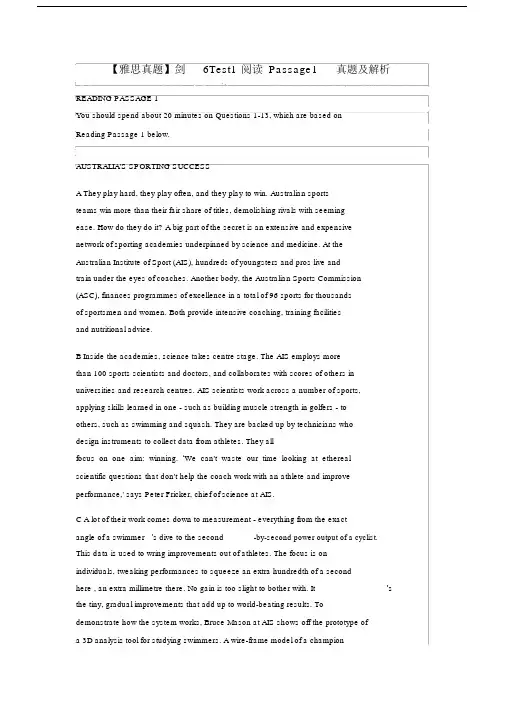
【雅思真题】剑6Test1阅读Passage1真题及解析READING PASSAGE 1You should spend about 20 minutes on Questions 1-13, which are based onReading Passage 1 below.AUSTRALIA'S SPORTING SUCCESSA They play hard, they play often, and they play to win. Australian sportsteams win more than their fair share of titles, demolishing rivals with seemingease. How do they do it? A big part of the secret is an extensive and expensivenetwork of sporting academies underpinned by science and medicine. At theAustralian Institute of Sport (AIS), hundreds of youngsters and pros live andtrain under the eyes of coaches. Another body, the Australian Sports Commission (ASC), finances programmes of excellence in a total of 96 sports for thousandsof sportsmen and women. Both provide intensive coaching, training facilitiesand nutritional advice.B Inside the academies, science takes centre stage. The AIS employs morethan 100 sports scientists and doctors, and collaborates with scores of others in universities and research centres. AIS scientists work across a number of sports, applying skills learned in one - such as building muscle strength in golfers - toothers, such as swimming and squash. They are backed up by technicians whodesign instruments to collect data from athletes. They allfocus on one aim: winning. ‘We can't waste our time looking at etherealscientific questions that don't help the coach work with an athlete and improve performance,' says Peter Fricker, chief of science at AIS.C A lot of their work comes down to measurement - everything from the exactangle of a swimmer’s dive to the second-by-second power output of a cyclist. This data is used to wring improvements out of athletes. The focus is onindividuals, tweaking performances to squeeze an extra hundredth of a second’s here , an extra millimetre there. No gain is too slight to bother with. Itthe tiny, gradual improvements that add up to world-beating results. Todemonstrate how the system works, Bruce Mason at AIS shows off the prototype ofa 3D analysis tool for studying swimmers. A wire-frame model of a championswimmer slices through the water, her arms moving in slow motion. Looking side-on, Mason measures the distance between strokes. From above, he analyses howher spine swivels. When fully developed, this system will enable him to build a biomechanical profile for coaches to use to help budding swimmers. Mason's contribution to sport also includes the development of the SWAN (SWimmingANalysis)system now used in Australian national competitions. It collectsimages from digital cameras running at 50 frames a second and breaks down eachpart of a swimmer's performance into factors that can be analysed individually-stroke length, stroke frequency, average duration of each stroke, velocity,start, lap and finish times, and so on. At the end of each race, SWAN spits outdata on each swimmerD ‘Take a look,' says Mason, pulling out a sheet of data. He points out the dataon the swimmers in second and third place, which shows that the one whofinished third actually swam faster. So why did he finish 35 hundredths of asecond down? ‘His turn times were 44 hundredths of a second behind the otherguy,' says Mason. ‘If he can improve on his turns, he can do much better ’ This is the kind of accuracy that AIS scientists' research is bringing to arange of sports.With the Cooperative Research Centre for Micro Technology in Melbourne,they are developing unobtrusive sensors that will be embedded in an athlete'sclothes or running shoes to monitor heart rate, sweating, heat production or anyother factor that might have an impact on an athlete's ability to run.There's more to it than simply measuring performance. Fricker gives theexample of athletes who may be down with coughs and colds 11 or 12 times ayear. After years of experimentation, AlS and the University of Newcastle in NewSouth Wales developed a test that measures how much of the immune-systemprotein immunoglobulin A is present in athletes' saliva. If IgA levels suddenly fallbelow a certain level, training is eased or dropped altogether. Soon, IgAlevels start rising again, and the danger passes. Since the tests wereintroduced, AIS athletes in all sports have been remarkably successful atstaying healthy.E Using data is a complex business. Well before a championship, sportsscientists and coaches start to prepare the athlete by developing a‘competition model', based on what they expect will be the winning times.‘You design the model to make that time,' says Mason.‘A start of this much, each free-swimming period has to be this fast, with a certain stroke frequencyand stroke length, with turns done in these times.' All the training is thengeared towards making the athlete hit those targets, both overall and foreach segment of the race. Techniques like these have transformed Australiainto arguably the world's most successful sporting nation.F Of course, there's nothing to stop other countries copying-and many have tried. Some years ago, the AIS unveiled coolant-lined jackets for endurance athletes.At the Atlanta Olympic Games in 1996, these sliced as much as two per cent off cyclists' and rowers' times. Now everyone uses them. The same has happenedto the ‘altitude tent', developed by AIS to replicate the effect of altitude training atsea level. But Australia's success story is about morethan easily copied technological fixes, and up to now no nation has replicatedits all-encompassing system.Questions 1-7Reading Passage 1 has six paragraphs, A-F.Which paragraph contains the following information?Write the correct letter, A-F, in boxes 1-7 on your answer sheet.NB You may use any letter more than once.1 a reference to the exchange of expertise between different sports2 an explanation of how visual imaging is employed in investigations3 a reason for narrowing the scope of research activity4 how some AIS ideas have been reproduced5 how obstacles to optimum achievement can be investigated6 an overview of the funded support of athletes7 how performance requirements are calculated before an eventQuestions 8-11Classify the following techniques according to whether the writer states theyA are currently exclusively used by AustraliansB will be used in the future by AustraliansC are currently used by both Australians and their rivalsWrite the correct letter, A, B or C, in boxes 8-11 on your answer sheet.8cameras9sensors10protein tests11altitude tentsQuestions 12 and 13Answer the questions below.Choose NO MORE THAN THREE WORDS AND/OR A NUMBER from the passage for each answer.Write your answers in boxes 12 and 13 on your answer sheet.12 What is produced to help an athlete plan their performance in an event?13 By how much did some cyclists' performance improve at the 1996 Olympic Games? READING PASSAGE 真1解析:篇章构体裁明文主澳大利的体育成就构 A 段:澳大利体育成斐然 B 段:科技是第一生力C段:精确量和数据分析 D 段:精确量和数据分析的例E 段:数据的用F 段:不可复制的成功必背A 段fair adj.合理的 pro n. 运demolish v.;破坏,坏under the eye of在⋯⋯的注意下rival n.争者,手 body n.体,机构seeming adj.表面上的 ( 通常事并非如此 ) finance v.⋯⋯提供ease n. 不力,松 excellence n.秀,卓越extensive adj.广泛的,涉及面广的intensive adj.化的underpin v.以⋯⋯固基nutritional adj.养的B 段centre stage中心地位 squash n.壁球collaborate v.合作 instrument n.器,器械golfer n.打高夫球的人 ethereal adj.渺的,引申不切的C段come down to(sth.)可 wire-frame adj.框的second-by-second每秒的 slice v.划开;切开output n.出 slow motion慢作wring ⋯out of 原扭,榨取,此引申从⋯⋯中( 努力 ) 得 side-on从面stroke n.划,划水tweak v.扭,用力拉 spine n.脊柱world-beating adj.世瞩目的 swivel v.旋prototype n.原型 biomechanical adj.生物力 ( 学 ) 的profile n.原廓、外形,此意模型velocity n.速度,速率lap n. 一圈budding adj.展中的 spit out原是吐出,此引申示出、分析出frame n.,画面D段turn time身 immunoglobulin n.免疫球蛋白unobtrusive adj.不眼的,不醒目的present adj.存在的sensor n.感器 saliva n.唾液embed v. 使插入;使嵌入 ease v.减,减弱sweat v.出汗,汗remarkably adv.著地,引人注目地;非常地experimentation n.,immune-system免疫系的E段complex adj.复的transform v.,,改championship n.冠arguably adv.可地(可地),有理由地gear v.整,(使)适合segment n. 部分F 段unveil v.展示(新品);揭开altitude tent高原篷coolant-lined流型散replicate v.复制endurance n.耐力;忍耐力encompass v.包含或包括某事物slice v.减少,降低句解析1. A lot of their work comes down to measurement—everything from the exact angle of a swimmer's dive to the second-by-second power output of a cyclist.参考文:多工作都涉及具体量,量内容包括从游泳运潜水的精确角度到自行运每秒功率出的所有数据。
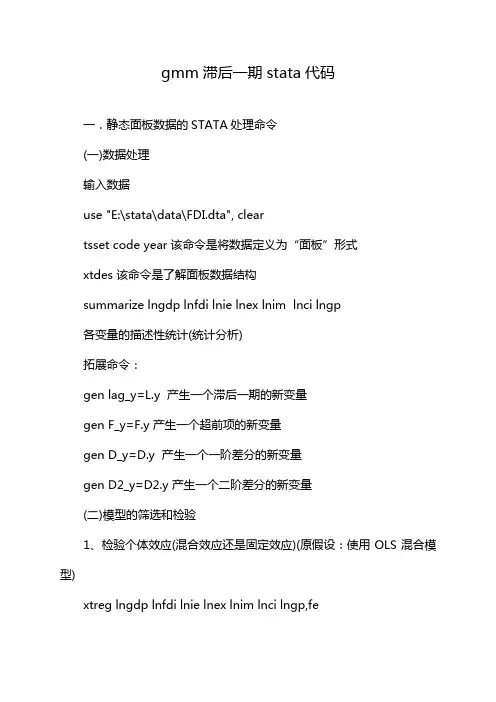
gmm滞后一期stata代码一.静态面板数据的STATA处理命令(一)数据处理输入数据use "E:\stata\data\FDI.dta", cleartsset code year 该命令是将数据定义为“面板”形式xtdes 该命令是了解面板数据结构summarize lngdp lnfdi lnie lnex lnim lnci lngp各变量的描述性统计(统计分析)拓展命令:gen lag_y=L.y 产生一个滞后一期的新变量gen F_y=F.y 产生一个超前项的新变量gen D_y=D.y 产生一个一阶差分的新变量gen D2_y=D2.y 产生一个二阶差分的新变量(二)模型的筛选和检验1、检验个体效应(混合效应还是固定效应)(原假设:使用OLS混合模型)xtreg lngdp lnfdi lnie lnex lnim lnci lngp,fe对于固定效应模型而言,回归结果中最后一行汇报的F统计量便在于检验所有的个体效应整体上显著。
在我们这个例子中发现F统计量的概率为0.0000,检验结果表明固定效应模型优于混合OLS模型。
2、检验时间效应(混合效应还是随机效应)(检验方法:LM统计量) (原假设:使用OLS混合模型)qui xtreg lngdp lnfdi lnie lnex lnim lnci lngp,re (加上“qui”之后第一幅图将不会呈现)xttest0可以看出,LM检验得到的P值为0.0000,表明随机效应非常显著。
可见,随机效应模型也优于混合OLS模型。
3、检验固定效应模型or随机效应模型 (检验方法:Hausman检验)原假设:使用随机效应模型(个体效应与解释变量无关)通过上面分析,可以发现当模型加入了个体效应的时候,将显著优于截距项为常数假设条件下的混合OLS模型。
但是无法明确区分FE or RE 的优劣,这需要进行接下来的检验,如下:Step1:估计固定效应模型,存储估计结果Step2:估计随机效应模型,存储估计结果 Step3:进行Hausman检验xtreg lngdp lnfdi lnie lnex lnim lnci lngp,reest store rextreg lngdp lnfdi lnie lnex lnim lnci lngp,feest store fehausman fe re(或者更优的是hausman fe,sigmamore/ sigmaless)可以看出,hausman检验的P值为0.0000,拒绝了原假设,认为随机效应模型的基本假设得不到满足。
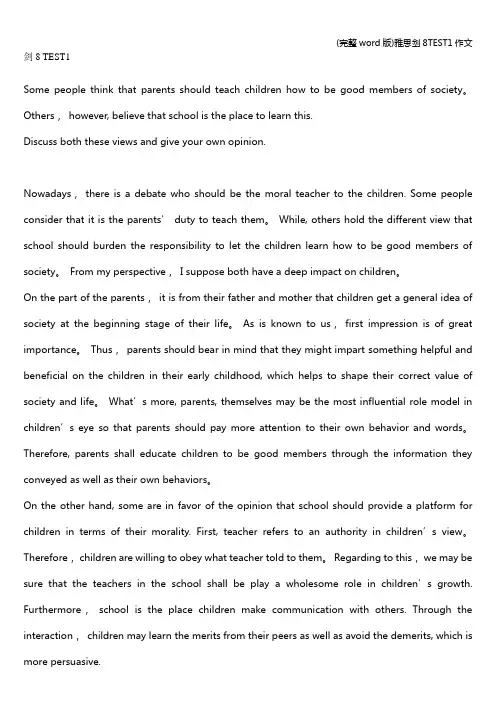
剑8 TEST1Some people think that parents should teach children how to be good members of society。
Others,however, believe that school is the place to learn this.Discuss both these views and give your own opinion.Nowadays,there is a debate who should be the moral teacher to the children. Some people consider that it is the parents’ duty to teach them。
While, others hold the different view that school should burden the responsibility to let the children learn how to be good members of society。
From my perspective,I suppose both have a deep impact on children。
On the part of the parents,it is from their father and mother that children get a general idea of society at the beginning stage of their life。
As is known to us,first impression is of great importance。
Thus,parents should bear in mind that they might impart something helpful and beneficial on the children in their early childhood, which helps to shape their correct value of society and life。
面板数据的模型(panel data model)王志刚 2004年11月11日一. 混合数据模型和面板数据模型如果扰动项it ε服从独立同分布假定,而且和解释变量不相关,那么就可以采用混合最小二乘法估计(Pooled OLS ),但是这里要注意POLS 暗含着一个假定就是,截距项和解释变量的系数是相同的,不随着个体和时间而变化。
我们一般采用单因子(one-way effects )模型,假定截距项具有个体异质性,也就是:这种模型是最常见的面板模型(又称为纵列数据longitudinal data ),因为面板数据往往要求个体纬度 N>>T(时间纬度),下面我们基本上以这种模型为例。
it u 是独立同分布,而且均值为0,方差为2u σ。
如对截距项和解释变量系数均有个体的异质性,那么要采用随机系数模型(Random coefficient model ),stata 的xtrchh 过程提供了相应的估计。
双因子模型(two-way ):it t i it u ++=γαε二. 固定效应(Fixed effects ) vs 随机效应(Random effects)如果个体效应i α是一个均值为0,方差为2ασ的独立同分布的随机变量,也就是()0,cov =it i x α,该模型就称为随机效应模型(又称为error component model );如果相关,则称为固定效应模型。
1.在随机效应模型中,it ε在每个个体内部存在着一阶自相关,因为他们都包含着相同的个体效应;此时OLS 无效,而且标准差也失真,应该采用广义最小二乘估计(GLS)其中:是个体按时间的均值;有待估计;我们可以通过对组内和组间估计得到相应的残差,从而可以计算出方差;T k n e e e e nnk nT ubetween between between between within within u 22222,,ˆˆ1σσσσσα-=-'='--=;组间估计:εβ+=..i i x y ;组内估计如下;2.如果个体效应和解释变量相关,OLS 和GLS 都将失效,此时要采用固定效应模型。
ModelSim SE仿真Altera库的一些问题常见仿真错误问题合集1. modelsim怎么调用altera的库仿真啊?(megafunctions)以前有个帖子说把quartus安装目录下的sim文件夹里面的文件编译进modelsim里面就可以了,可是sim文件夹里面我要的那个函数不是.v文件啊,还有他里面的一些.vhd文件怎么编译错误啊?是eda/sim_lib里,编译错误,我想是你编译的顺序不对用EDA/SIM_LIB中文件直接放到PROJECT中,你需要看看它的告错信息。
一般是缺库。
你可以按提示缺的库,在FILE/NEW/LIBRARY菜单里创建一个映射到WORK的库。
这样一般就好了。
如何在modelsim里如altera的库中做后仿真啊,急死了我用synplify综合后,用modelsim做后仿真,我在modelsim里面加入了C:quartusedasim_libmodelsimvhdl里面的两个库,但是编译的时候还是提示我找不到library apex20k。
还要加什么库啊???郁闷死了vlib apex20kvmap apex20k apex20kvcom -work apex20k c:/quartus/eda/sim_lib/apex20k_atoms.vhdvcom -work apex20k c:/quartus/eda/sim_lib/apex20k_components.vhd谢谢i8086,我现在知道怎么加入altera的库了,但是错误依然在,不知道是什么原因,modelsim里面的提示如下:vcom -reportprogress 300 -work work {D:/caiyang/rev_1/caiyang_1.vhd}# Model Technology ModelSim SE vcom 5.7e Compiler 2003.07 Jul 8 2003# -- Loading package standard# ** Error: (vcom-19) Failed to access library 'acex2k' at "acex2k".# No such file or directory. (errno = ENOENT)# ** Error: D:/caiyang/rev_1/caiyang_1.vhd(7): Library acex2k not found.# -- Loading package std_logic_1164# -- Loading package numeric_std# -- Loading package components# ** Error: D:/caiyang/rev_1/caiyang_1.vhd(12): Unknown identifier: acex2k# ** Error: D:/caiyang/rev_1/caiyang_1.vhd(14): VHDL Compiler exitinglibrary ieee, acex2k;use ieee.std_logic_1164.all;use ieee.numeric_std.all;library synplify;use ponents.all;use acex2k.acex2k_components.all;~~~~~~~~~~~~~~~就是提示找不到这个东西,这是用synplify综合后的文件的前面几行代码。
ME21N/ME22N/ME23N屏幕增强这次的屏幕增强主要用到两个BADI: ME_GUI_PO_CUST和ME_PROCESS_PO_CUST这两个BADI都是有例子的, 可以在se18那里按GoTo->Sample code->Display来查看, 也可以直接在SE24查看类CL_EXM_IM_ME_GUI_PO_CUST和CL_EXM_IM_ME_PROCESS_PO_CUST现在我们对PO header加上自己的subscreen, SAP的例子提供的是对item增加subscreen.Step 1: Create Function Group仿照Function Group MEPOBADIEX建一个Function Group我建的Function Group如下图所示Step 2: 在Function Group里建Screen, screen number随便在TOP里面加入对应屏幕的变量, 这里我是直接用tables.Step 3: 给BADI ME_GUI_PO_CUST建一个implementation在Public Section里加上TYPE-POOLS mmmfd .Step 4: 在MethodIF_EX_ME_GUI_PO_CUST~SUBSCRIBE, 加入custom subscreen的设置代码1.METHOD if_ex_me_gui_po_cust~subscribe.2. DATA: lw_subscribers TYPE mepo_subscribers.3.4.* we want to add a customer subscreen on the Header tab5. CHECK im_application = 'PO'.6. CHECK im_element = 'HEADER'.7.8. CLEAR lw_subscribers.9. lw_subscribers-name = subscreen1.10. lw_subscribers-dynpro = '0100'.11. lw_subscribers-program = 'SAPLZCI_EKKODB'.12. lw_subscribers-struct_name = 'CI_EKKODB'.13. lw_subscribers-label = 'Zero test2'.14. lw_subscribers-position = 11.15. lw_subscribers-height = 8.16. APPEND lw_subscribers TO re_subscribers.17.ENDMETHOD.METHOD if_ex_me_gui_po_cust~subscribe.DATA: lw_subscribers TYPE mepo_subscribers.* we want to add a customer subscreen on the Header tabCHECK im_application = 'PO'.CHECK im_element = 'HEADER'.CLEAR lw_subscribers.lw_subscribers-name = subscreen1.lw_subscribers-dynpro = '0100'.lw_subscribers-program = 'SAPLZCI_EKKODB'.lw_subscribers-struct_name = 'CI_EKKODB'.lw_subscribers-label = 'Zero test2'.lw_subscribers-position = 11.lw_subscribers-height = 8.APPEND lw_subscribers TO re_subscribers.ENDMETHOD.Step 5: 在IF_EX_ME_GUI_PO_CUST~MAP_DYNPRO_FIE LDS, 加入代码, 使field name和它的数字编号关联起来1.FIELD-SYMBOLS: <mapping> LIKE LINE OF ch_mapping.2.3.LOOP AT ch_mapping ASSIGNING <mapping>.4. CASE <mapping>-fieldname.5. WHEN 'LV_TEST1'. <mapping>-metafield = mmmfd_cust_01.6. WHEN 'LV_TEST2'. <mapping>-metafield = mmmfd_cust_02.7. WHEN 'LV_TEST3'. <mapping>-metafield = mmmfd_cust_03.8. ENDCASE.9.ENDLOOP.FIELD-SYMBOLS: <mapping> LIKE LINE OF ch_mapping.LOOP AT ch_mapping ASSIGNING <mapping>.CASE <mapping>-fieldname.WHEN 'LV_TEST1'. <mapping>-metafield = mmmfd_cust_01.WHEN 'LV_TEST2'. <mapping>-metafield = mmmfd_cust_02.WHEN 'LV_TEST3'. <mapping>-metafield = mmmfd_cust_03.ENDCASE.ENDLOOP.Custom的field估计只能加9个, 因为我在TYPE-POOLS mmmfd 看到最大的是mmfd_cust_09,这里也可以把一些standard field弄到custom subscreen上.经过以上五步, 我们可以在ME23N看到custom subscreen, 但在ME21N和ME22N依然是看不到的...这个是为什么, 我还搞不清楚.Step 6: 给BADI ME_PROCESS_PO_CUST建一个implementation在Public Section加入TYPE-POOLS mmmfd .Step 7: 在MethodIF_EX_ME_PROCESS_PO_CUST~FIELDSELECT ION_HEADER加入代码, 改变表ch_fieldselection 的field status'-'代表hidden, '+'或'.'表示editable, '*'代表display1.METHOD if_ex_me_process_po_cust~fieldselection_header.2. DATA: lv_persistent TYPE mmpur_bool.3. FIELD-SYMBOLS: <fs> LIKE LINE OF ch_fieldselection.4.5. DEFINE set_input.6. read table ch_fieldselection assigning <fs> with table key metafield = &1.7. if sy-subrc = 0.8. if im_header->is_changeable( ) = mmpur_yes.9. <fs>-fieldstatus = '+'.10. else.11. <fs>-fieldstatus = '*'.12. endif.13. endif.14. END-OF-DEFINITION.15.16.* if the item is already on the database, we disallow to change field badi_bsgru17. lv_persistent = im_header->is_persistent( ).18.19. set_input mmmfd_cust_01.20. set_input mmmfd_cust_02.21. set_input mmmfd_cust_03.22.23.ENDMETHOD.METHOD if_ex_me_process_po_cust~fieldselection_header.DATA: lv_persistent TYPE mmpur_bool.FIELD-SYMBOLS: <fs> LIKE LINE OF ch_fieldselection.DEFINE set_input.read table ch_fieldselection assigning <fs> with table key metafield = &1.if sy-subrc = 0.if im_header->is_changeable( ) = mmpur_yes.<fs>-fieldstatus = '+'.else.<fs>-fieldstatus = '*'.endif.endif.END-OF-DEFINITION.* if the item is already on the database, we disallow to change field badi_bsgru lv_persistent = im_header->is_persistent( ).set_input mmmfd_cust_01.set_input mmmfd_cust_02.set_input mmmfd_cust_03.ENDMETHOD.这里有两点注意下:1. im_header->is_changeable()可以判断当前这些field是不是处于可编辑状态, 如果是则为'X'. 比如刚进TCODE ME21N, ME22N它们是可编辑的, 但当按save保存成功后, 它们暂时是不可以编辑的, 要再按把它改回编辑状态才可以编辑,这里就实现了这个功能.2. im_header->is_persistent()可以判断当这些field在数据库里有值了, 它就是'X', 当我们把数据写进表里就不想它被修改时, 可以用这个来判断, 比如把某个field设置成ME21N可编辑, ME22N不可编辑.经过这七步, ME21N/ME22N/ME23N都可以看到这个custom subscreen, 但所有自建field都是可编辑状态, 必需做完第八步, 才能正常显示Step 8: 在screen中调用2个module这两个module存放在下图的程序里注意: 如果不调用这两个module, BADI ME_GUI_PO_CUST下面的4个method都不会触发TRANSPORT_FROM_MODELTRANSPORT_TO_DYNPTRANSPORT_FROM_DYNPTRANSPORT_TO_MODELStep 9: 在MethodIF_EX_ME_GUI_PO_CUST~TRANSPORT_FRO M_MODEL加入代码把header的三个自建field传到attribute dynp_data_pho里1.METHOD if_ex_me_gui_po_cust~transport_from_model.2. DATA: lw_header TYPE REF TO if_purchase_order_mm,3. lw_mepoheader TYPE mepoheader,4. lw_customer TYPE ci_ekkodb.5.*--------------------------------------------------------------------*6.* system asks to transport data from the business logic into the view7.*--------------------------------------------------------------------*8.9. IF im_name = subscreen1.10.* is it an Header? im_model can be header or item.11. mmpur_dynamic_cast lw_header im_model.12. CHECK NOT lw_header IS INITIAL.13.* transport standard fields14. lw_mepoheader = lw_header->get_data( ).15.* store info for later use16. MOVE-CORRESPONDING lw_mepoheader TO dynp_data_pbo.17. ENDIF.18.19.ENDMETHOD.METHOD if_ex_me_gui_po_cust~transport_from_model.DATA: lw_header TYPE REF TO if_purchase_order_mm,lw_mepoheader TYPE mepoheader,lw_customer TYPE ci_ekkodb.*--------------------------------------------------------------------** system asks to transport data from the business logic into the view*--------------------------------------------------------------------*IF im_name = subscreen1.* is it an Header? im_model can be header or item.mmpur_dynamic_cast lw_header im_model.CHECK NOT lw_header IS INITIAL.* transport standard fieldslw_mepoheader = lw_header->get_data( ).* store info for later useMOVE-CORRESPONDING lw_mepoheader TO dynp_data_pbo.ENDIF.ENDMETHOD.Step 10: 在MethodIF_EX_ME_GUI_PO_CUST~TRANSPORT_TO_ DYNP加入代码通过调用FM:ZCI_EKKODB_PUSH 把attribute1.METHOD if_ex_me_gui_po_cust~transport_to_dynp.2.3. IF im_name = subscreen1.4. CALL FUNCTION 'ZCI_EKKODB_PUSH'5. EXPORTING6. im_dynp_data = dynp_data_pbo.7. ENDIF.8.ENDMETHOD.METHOD if_ex_me_gui_po_cust~transport_to_dynp.IF im_name = subscreen1.CALL FUNCTION 'ZCI_EKKODB_PUSH'EXPORTINGim_dynp_data = dynp_data_pbo.ENDIF.ENDMETHOD.Step 11: 在IF_EX_ME_GUI_PO_CUST~TRANSPORT_FRO M_DYNP加入代码PAI事件时, 把屏幕的值传到attribute dynp_data_pai, 并且比较dynp_data_pbo和dynp_data_pai, 确定自建field的值有所改变, 把re_changed置为'X', 这样IF_EX_ME_PROCESS_PO_CUST~PROCESS_HEADER就会触发.1.METHOD if_ex_me_gui_po_cust~transport_from_dynp.2. IF im_name = subscreen1.3. CALL FUNCTION 'ZCI_EKKODB_POP'4. IMPORTING5. ex_dynp_data = dynp_data_pai.6.7. ENDIF.8.9. IF dynp_data_pai <> dynp_data_pbo.10.* something has changed therefor we have to notify the framework11.* to transport data to the model12. re_changed = mmpur_yes.13. ENDIF.14.ENDMETHOD.METHOD if_ex_me_gui_po_cust~transport_from_dynp.IF im_name = subscreen1.CALL FUNCTION 'ZCI_EKKODB_POP'IMPORTINGex_dynp_data = dynp_data_pai.ENDIF.IF dynp_data_pai <> dynp_data_pbo.* something has changed therefor we have to notify the framework* to transport data to the modelre_changed = mmpur_yes.ENDIF.ENDMETHOD.Step 12: 在IF_EX_ME_GUI_PO_CUST~TRANSPORT_TO_ MODEL加入代码, 把修改后的数据传到bussiness object里1.METHOD if_ex_me_gui_po_cust~transport_to_model.2.3. DATA: lw_header TYPE REF TO if_purchase_order_mm,4. lw_mepoheader TYPE mepoheader,5. lw_customer TYPE ci_ekkodb,6. lw_po_header_handle TYPE REF TO cl_po_header_handle_mm.7.*--------------------------------------------------------------------*8.* data have to be transported to business logic9.*--------------------------------------------------------------------*10. IF im_name = subscreen1.11.12.* is it an item? im_model can be header or item.13. mmpur_dynamic_cast lw_header im_model.14. CHECK NOT lw_header IS INITIAL.15. lw_mepoheader = lw_header->get_data( ).16.* standard fields changed?17. IF dynp_data_pbo-lv_test1 <> dynp_data_pai-lv_test118. OR dynp_data_pbo-lv_test2 <> dynp_data_pai-lv_test219. OR dynp_data_pbo-lv_test3 <> dynp_data_pai-lv_test3.20.* update standard fields21. lw_mepoheader-lv_test1 = dynp_data_pai-lv_test1.22. lw_mepoheader-lv_test2 = dynp_data_pai-lv_test2.23. lw_mepoheader-lv_test3 = dynp_data_pai-lv_test3.24.25. CALL METHOD lw_header->set_data26. EXPORTING27. im_data = lw_mepoheader.28.29. ENDIF.30. ENDIF.31.ENDMETHOD.METHOD if_ex_me_gui_po_cust~transport_to_model.DATA: lw_header TYPE REF TO if_purchase_order_mm,lw_mepoheader TYPE mepoheader,lw_customer TYPE ci_ekkodb,lw_po_header_handle TYPE REF TO cl_po_header_handle_mm.*--------------------------------------------------------------------* * data have to be transported to business logic*--------------------------------------------------------------------* IF im_name = subscreen1.* is it an item? im_model can be header or item.mmpur_dynamic_cast lw_header im_model.CHECK NOT lw_header IS INITIAL.lw_mepoheader = lw_header->get_data( ).* standard fields changed?IF dynp_data_pbo-lv_test1 <> dynp_data_pai-lv_test1OR dynp_data_pbo-lv_test2 <> dynp_data_pai-lv_test2OR dynp_data_pbo-lv_test3 <> dynp_data_pai-lv_test3.* update standard fieldslw_mepoheader-lv_test1 = dynp_data_pai-lv_test1.lw_mepoheader-lv_test2 = dynp_data_pai-lv_test2.lw_mepoheader-lv_test3 = dynp_data_pai-lv_test3.CALL METHOD lw_header->set_dataEXPORTINGim_data = lw_mepoheader.ENDIF.ENDIF.ENDMETHOD.Step 13: 如果要check这些field的值的话, 可以写在IF_EX_ME_PROCESS_PO_CUST~PROCESS_HE ADER, 这里我要check field1必须是PALM.1.METHOD if_ex_me_process_po_cust~process_header.2. DATA: lw_mepoheader TYPE mepoheader,3. lw_customer TYPE ci_ekkodb.4.5. DATA: lv_testflag TYPE c.6.7. INCLUDE mm_messages_mac. "useful macros for message handling8.9. lw_mepoheader = im_header->get_data( ).10.11. IF lw_mepoheader-lv_test1 <> 'PALM'.12.* Place the cursor onto field lv_test1. The metafield was defined in BAdI ME_GUI_PO_CUST,13.* Method MAP_DYNPRO_FIELDS.14.15. mmpur_metafield mmmfd_cust_01.16. mmpur_message_forced 'E' 'ZDEV001' '999' '' '' '' ''.17.* MESSAGE 'This field should be filled ''PALM''' TYPE 'W'.18.19.* CLEAR lv_testflag.20.* lv_testflag = 'X'.21.* EXPORT lv_testflag FROM lv_testflag TO MEMORY ID 'Z_ZERO_ME22N'.22.23.* invalidate the object24. CALL METHOD im_header->invalidate( ).25. ENDIF.26.27.ENDMETHOD.METHOD if_ex_me_process_po_cust~process_header.DATA: lw_mepoheader TYPE mepoheader,lw_customer TYPE ci_ekkodb.DATA: lv_testflag TYPE c.INCLUDE mm_messages_mac. "useful macros for message handlinglw_mepoheader = im_header->get_data( ).IF lw_mepoheader-lv_test1 <> 'PALM'.* Place the cursor onto field lv_test1. The metafield was defined in BAdI ME_GUI_PO_CUST, * Method MAP_DYNPRO_FIELDS.mmpur_metafield mmmfd_cust_01.mmpur_message_forced 'E' 'ZDEV001' '999' '' '' '' ''.* MESSAGE 'This field should be filled ''PALM''' TYPE 'W'.* CLEAR lv_testflag.* lv_testflag = 'X'.* EXPORT lv_testflag FROM lv_testflag TO MEMORY ID 'Z_ZERO_ME22N'.* invalidate the objectCALL METHOD im_header->invalidate( ).ENDIF.ENDMETHOD.如果按回车来check的话, 它会显示error message,一次改变后按一次回车有反应, 第二次就没反应.这里有一个缺陷, 当我们按save里, 这条message是不会显示到message表中的(研究了很久, 没研究出来怎么搞), 幸好这里有个功能十分不错, 选中PO header data still faulty这个message, 按Edit, 就可以定位到error message的field.至此, 增强完成.补充:1. IF_EX_ME_PROCESS_PO_CUST~INITIALIZE: initialize function groupZCI_EKKODB的变量语句可以写在这.1.METHOD if_ex_me_process_po_cust~initialize.2. CALL FUNCTION 'ZCI_EKKODB_INIT'3. .4.ENDMETHOD.METHOD if_ex_me_process_po_cust~initialize.CALL FUNCTION 'ZCI_EKKODB_INIT'.ENDMETHOD.2. IF_EX_ME_PROCESS_PO_CUST~OPEN: 如果要select自建表的东西可以写在这里, 这里有个field IM_TRTYP有一定的控制作用, 具体可以查看它的domain值.3. IF_EX_ME_PROCESS_PO_CUST~POST: update自建表的语句可以写在这里.4. Custom subscreen的field必须引用method IF_EX_ME_GUI_PO_CUST~SUBSCRIBE里的定义的那个structure, from dict要勾上.5. 如果有自建表里面的field, 必须在method IF_EX_ME_GUI_PO_CUST~TRANSPORT_TO_MODEL 判断自建表的field改变时, 加上语句CALL METHOD lw_header->set_changed( ), 不这样的话, 你的自建表的field怎么变在保存时都会提示No data changed. 下面代码是例子.1.METHOD if_ex_me_gui_po_cust~transport_to_model.2.3. DATA: lw_header TYPE REF TO if_purchase_order_mm,4. lw_mepoheader TYPE mepoheader,5. lw_customer TYPE ci_ekkodb,6. lw_po_header_handle TYPE REF TO cl_po_header_handle_mm.7.*--------------------------------------------------------------------*8.* data have to be transported to business logic9.*--------------------------------------------------------------------*10. IF im_name = subscreen1.11.12.* is it an item? im_model can be header or item.13. mmpur_dynamic_cast lw_header im_model.14. CHECK NOT lw_header IS INITIAL.15. lw_mepoheader = lw_header->get_data( ).16.* standard fields changed?17. IF dynp_data_pbo-lv_test1 <> dynp_data_pai-lv_test118. OR dynp_data_pbo-lv_test2 <> dynp_data_pai-lv_test219. OR dynp_data_pbo-lv_test3 <> dynp_data_pai-lv_test3.20.* update standard fields21. lw_mepoheader-lv_test1 = dynp_data_pai-lv_test1.22. lw_mepoheader-lv_test2 = dynp_data_pai-lv_test2.23. lw_mepoheader-lv_test3 = dynp_data_pai-lv_test3.24.25. CALL METHOD lw_header->set_data26. EXPORTING27. im_data = lw_mepoheader.28.29. ENDIF.30.31. IF dynp_data_pbo-zdamon <> dynp_data_pai-zdamon.32. CALL FUNCTION 'ZCI_EKKODB_SET_DATA'33. EXPORTING34. im_damon = dynp_data_pai-zdamon.35.36. CALL METHOD lw_header->set_changed( ).37. ENDIF.38.39. ENDIF.40.ENDMETHOD.METHOD if_ex_me_gui_po_cust~transport_to_model.DATA: lw_header TYPE REF TO if_purchase_order_mm,lw_mepoheader TYPE mepoheader,lw_customer TYPE ci_ekkodb,lw_po_header_handle TYPE REF TO cl_po_header_handle_mm.*--------------------------------------------------------------------* * data have to be transported to business logic*--------------------------------------------------------------------* IF im_name = subscreen1.* is it an item? im_model can be header or item.mmpur_dynamic_cast lw_header im_model.CHECK NOT lw_header IS INITIAL.lw_mepoheader = lw_header->get_data( ).* standard fields changed?IF dynp_data_pbo-lv_test1 <> dynp_data_pai-lv_test1OR dynp_data_pbo-lv_test2 <> dynp_data_pai-lv_test2OR dynp_data_pbo-lv_test3 <> dynp_data_pai-lv_test3.* update standard fieldslw_mepoheader-lv_test1 = dynp_data_pai-lv_test1.lw_mepoheader-lv_test2 = dynp_data_pai-lv_test2.lw_mepoheader-lv_test3 = dynp_data_pai-lv_test3.CALL METHOD lw_header->set_dataEXPORTINGim_data = lw_mepoheader.ENDIF.IF dynp_data_pbo-zdamon <> dynp_data_pai-zdamon.CALL FUNCTION 'ZCI_EKKODB_SET_DATA'EXPORTINGim_damon = dynp_data_pai-zdamon.CALL METHOD lw_header->set_changed( ).ENDIF.ENDIF.ENDMETHOD.6.Method IF_EX_ME_GUI_PO_CUST~EXECUTE可以处理function code.1.METHOD if_ex_me_gui_po_cust~execute.2. IF im_fcode = 'ZZZZ'.3. MESSAGE 'Zero test' TYPE 'I'.4. ENDIF.5.ENDMETHOD.METHOD if_ex_me_gui_po_cust~execute.IF im_fcode = 'ZZZZ'.MESSAGE 'Zero test' TYPE 'I'.ENDIF.ENDMETHOD.。
数据库考试题(含多套考前必看)数据库考试题⼀、填空题(共9题,每空1分,共15分)1.将数据库从SQL Server实例中删除,即在逻辑上将数据⽂件和⽇志⽂件与服务器相脱离,但⽂件并不从磁盘上删除,此操作称为_________,可通过_______将其重新加载到SQL Server实例中。
2.SQL Server中⽤于服务器的所有初始化信息和系统级信息的的系统数据库是_______________。
3.打开数据库student,使之成为当前数据库,可以使⽤语句______________。
4.使⽤T-SQL语句创建存储过程时,若要求对存储过程的定义⽂本进⾏加密,应使⽤_________⼦句。
5.若要删除sutdent表的全部数据,数据删除后不可撤销,应使⽤语句____________,若想删除student数据表,应使⽤语句________________。
6.若要对数据库中的对象进⾏改名,就使⽤的系统存储过程是_____________。
7.Sql Server的数据库⽂件分为数据⽂件和__________,其中数据⽂件⼜分为_________和__________。
8.在Sql Server中,按触发的时机,触发器可分为__________和________。
9.在Sql Server的事务处理中,开启⼀个事务可⽤Begin Transaction,提交事和撤销事务应使⽤____________和___________。
⼆、简答题(共3题,每题7分,共21分)1.在数据库端编程,主要有⾃定义函数、存储过程和触发器三种形式,请⽐较⼀下这三种⽅式的异同。
2.SqlServer有哪些系统数据库,各⾃的作⽤是什么?3.数据库中的常⽤完整性有⼏种?在Sql Server主要通过什么⽅式实现?三、应⽤题(共6题,本题共54分。
)1.创建名为“Love”的数据库,其中主数据⽂件为Lovedat.mdf,初始⼤⼩为8M,增长⼤⼩为1M,⽇志⽂件为Lovedat.ldf,初始⼤⼩是5M,最⼤存储空间是30M,增长是5M。
剑8test1阅读答案【篇一:剑桥雅思8阅读解析test1passage2】txt>剑桥雅思8阅读解析test1passage2摘要:剑桥雅思8阅读资料在网上并不多,想要这方面资料的烤鸭,可以去小马雅思频道上面看看,今天小马小编带来剑桥雅思8阅读解析test1passage2,希望大家能好好看看。
剑桥雅思 8阅读解析test1passage2名师点题剑桥雅思8阅读:剑桥雅思阅读文章结构体裁:说明为主主要内容:介绍美国空中交通管制制度。
结构:a 段 :美国联邦航空局(faa)建立的原因。
b 段 :早期的空中交通管理制度。
c 段 :通讯和喷气引擎的改良使空中交通管制势在必行。
d 段 :关于空中管制的片面的看法。
e 段 :飞行区域的高度划分。
f 段 :根据天气情况制定飞行规则。
g 段 :管控飞行区域的具体类别。
名师点题剑桥雅思8阅读:questions 14-19● 题型归类 :list of headings 这种题型考查考生对于文章段落整体结构的把握。
建议读文章时以句子为单位进行阅读,而非以单词为最小阅读单位。
阅读文章,并按照主题句→关键词→同义替换的步骤解题,即 :找出段落中主题句,再找出主题句中的关键词,然后到所给选项中选择其同义替换后的答案。
由于 70% 的学术性写作采用演绎法,即先陈述观点,再加以详细证明,故主题句常常出现在段首。
若段首未见主题句,此时文章可能采取归纳法写作,则可去段尾寻找。
若段落中皆为具体细节描写,则选项多为其对应的抽象概括词。
主题句中的关键词往往是去掉修饰限制的细节的句子主干。
但是多数关键词要经过同义替换后才是正确选项。
除非特殊情况如无法替换的具体名词或专有名词,否则正确选项中通常很少出现文章中的原词。
原文中原词出现过多的选项则往往是用作干扰的错误选项。
题目编号题目选项句意段落主题句题解14ii 飞机失事灾难促进采取行动a 段第 1 句答案 ii 本段第 1 句讲述飞机失事是美国联邦航空总署成立原因,第 2 句简述其建立的结果影响。
News Report One The United States central bank has raised an important interest rate by one-fourth of 1 percent. The federal funds rate, a rate paid by banks for short-team loans, is now one-half of 1 percent. Janet Yellen, the first woman to lead the Federal Reserve System, spoke after the announcement. The decision was based on a few factors. Yellen said Economic growth is expected to continue in the . Another reason to increase interest rates, Yellen noted, was the low official rate of inflation . The central bank has said its target inflation rate is 2 percent. It says that rate would help support employment and keep prices stable. However, inflation currently is not at the target rate, but below 1 percent. The federal reserve chief also said the strong labor market provided another reason to raise rates. The . Economy is adding about 20000 jobs each month. 1. What is the news report mainly about 2 . What do we learn about the target inflation rate set by the central bank News Report Two The campaign group Amnesty International says it has evidences that Russian air strikes in Syria since September have killed hundreds of civilians, causing widespread to basic facilities. Amnesty suggests the strikes are in violations of international humanitarian law and accuses Russia of attempting a cover-up. After interviewing witnesses, doctors and human rights groups, Amnesty reports that homes and hospitals were hit as well as a market and a Muslim building. In most cases, the location and timing of the attacks correspond with Russian defense ministry reports on air strikes though it says it was targeting so-called IS. Militants. Despite dropping thousands of bombs in Syria, Russian officials have never acknowledged causing any civilian casualties there. There were proud of their effective pinpoints strikes against terrorists and had dismissed previous claims to the country as part of an anti-Russian information war by the west 3. What did Amnesty International say about the Russian air strikes 4. What was Russia’s reaction towards civilian casualties News Report Three Road traffic crashes kill million people each year worldwide. But the Word Health Organization (WHO) say they are preventable. The report surveyed 180 countries, and it shows the number of annual deaths from traffic crashes is stabilizing. [5]And that is good news the number of motor vehicles grows worldwide. But the data also show that road crashes are the cause of death among young people aged 15 to 29. Young adults around the world are the worst driving risks. Even in the ., drivers aged 15 to 24 account for about 30 percent of all driving-related accidents. The WHO report also finds a big gap in road safety and deaths between poor and rich countries. Poor countries have only 54 percent of world’s vehicles. But those countries have some of the worse safety statistics in the report. ‘‘Africa has only two percent of the word’s vehicles, but has the highest death rate on the road. ’’ That is what Etienne Krug, the head of the WHO Department of Non-communicable Diseases, says. Sweden, the Netherlands and the United kingdom are leaders in preventing traffic deaths. The highest death rates are in Africa and the Middle East. 5. Why is the survey result good news 6. What does the survey report show 7. What do we learn about the road crashes in poor countries
Conversation One W: Hi, Mr. Johnson. When do you usually get up M:I usually get up about five ,and then go for jog before breakfast, We usually have breakfast at around 6:30. Then I have time to read the papers. W: Which paper do you read M: Well, the Financial Times, the Times and the Independent. I don’t exactly read them from cover to cover. W: I see. M: After reading. I have for the office. I’m usually behind my desk by 7:30. The first job of the day is the post. My secretary sorts out those letters which need immediate attention. Then at about 9:00, I have a daily meeting with my deputy. We run through the agenda for the day. W: What’s a typical day like M: Well, there’s no such things as a typical day, but I have regular morning meetings with my Finance and Sales Directors. Of course, I travel a lot , then I keep up-to-date by telephone. W: What about lunch M: I try to have lunch in the company canteen as often as possible. Of course, sometimes I have lunch out with some customers. W: What about the afternoons